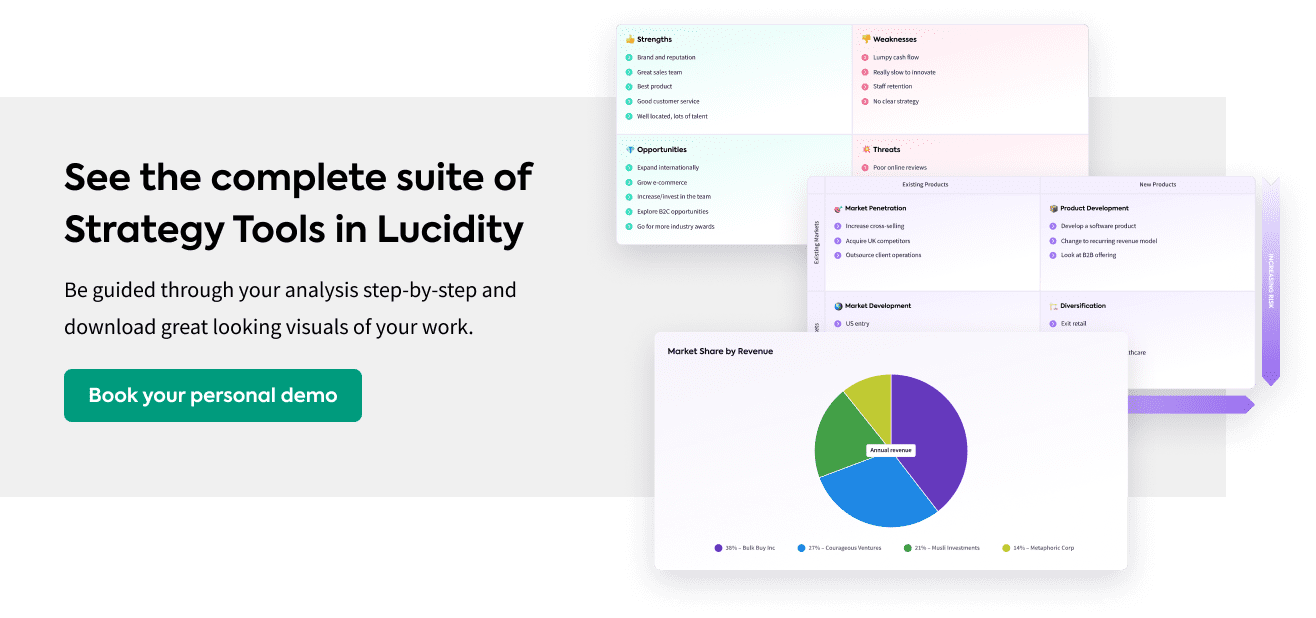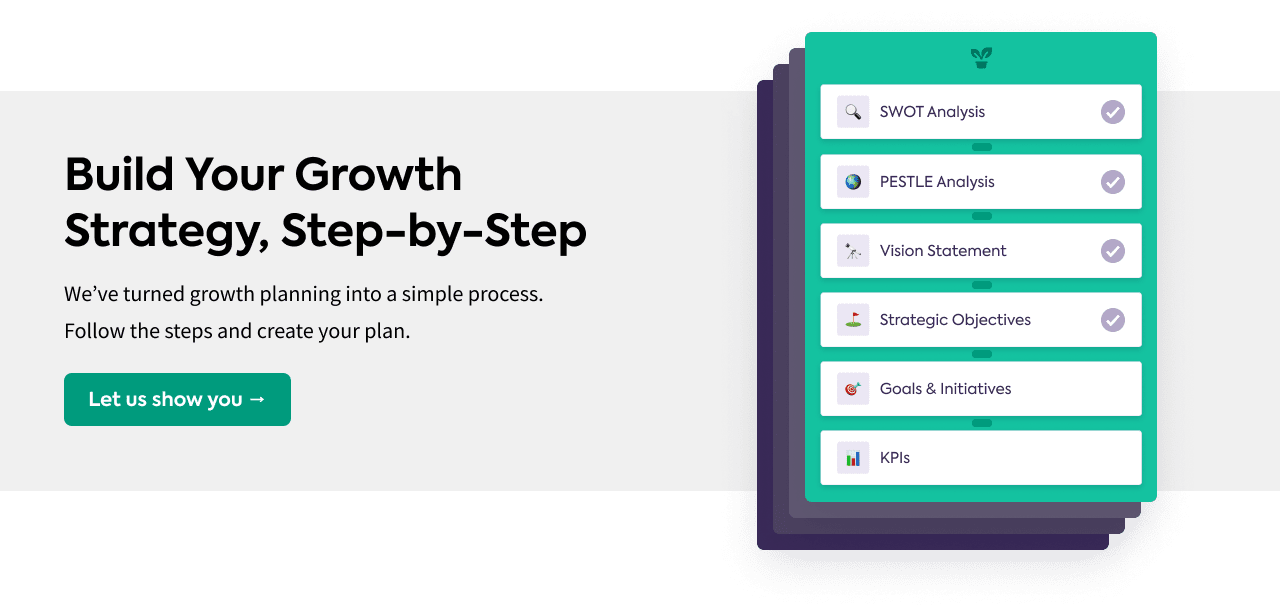You’ve carefully crafted your strategy and you’re ready to execute! But how do you know if you’ll be successful? Have you factored in all the important aspects that will help your company grow?
This article looks at the 5Ps of Strategy, a framework designed to help you critically evaluate your strategic plans and therefore increase your chances of success.
Let’s learn more…
What are Mintzberg’s 5 Ps of Strategy?
The 5 Ps of Strategy is a theory used in business to help companies better define their strategy. Each P relates to a different approach for assessing a strategy:
- Plan
- Ploy
- Pattern
- Position
- Perspective
By looking at each of these Ps in the context of your strategy, Mintzberg suggested you would have a greater chance of overall success.
These 5 Ps were developed as a framework through which you can assess the strength of a business strategy. So they are not a framework that helps you build your strategy, or a way of structuring your plan. Rather, the 5 Ps are intended as a way to test and examine the merits of your strategy once you have produced it. When you have a strategy that you believe is ready to execute, you pause, bring up this guide, and set about interogating that strategy against each P. No doubt you’ll discover some holes, some areas that need to be tightened up and some aspects that could do with refining. THAT is the purpose of Mintzberg’s 5 Ps of Strategy – to robustly challenge your strategy and show you how to make it better so it stands the greatest chance of success.
So let’s look at each P and see what questions you need to ask at each stage to make your strategy the best it can be…
What is Plan in Mintzberg’s 5 Ps of Strategy?
Planning is a natural component of any strategy. The two are intrinsically linked, what with the need to have a plan in order for any strategic execution to be performed. But planning and strategy are not the same thing. Planning is one part of a strategy and it alone is not enough for success.
So, how do you plan effectively? In the strategic sense, part of the planning phase is to understand the wider environment, your place within it, and the consequences of that position on your decisions. That is what this P is all about – assessing whether proper analysis has fed into your strategy planning.
Helpful Tools:
- Plan by understanding the wider environment with a PESTLE
- Plan by setting clear Strategic Objectives
- Plan by understanding your internal strengths and weaknesses with SWOT
The words strategy and plan are often interchangeable in discussion, but it’s important to step back and evaluate certain aspects of your strategy to determine whether the right level of planning has taken place. Do your strategic objectives have a real plan underneath them to ensure you hit your targets? Are those intended objectives backed up with insight and intelligence? Did you create those strategic objectives after doing some proper industry analysis?
What is Ploy in Mintzberg’s 5 Ps of Strategy?
Ploy is about specific actions within your strategy that relate to the competition. It might be to disrupt them, take market share from them or, if you’re like Nike in the 1960s, “crush” them. The purpose of Ploy is to ensure you have considered your competitive strategy and have a plan to get the better of the competition through a specific, chosen approach.
Helpful Tools:
- Understand the current market using Five Forces
- Establish your competitor strategy using Four Corner Analysis
In order for Ploy to be effective, you must ensure you have a good understanding of your competitive landscape. So, when evaluating your strategy, this is about ensuring there are aspects of it that specifically relate to the competition.
What is Pattern in Mintzberg’s 5 Ps of Strategy?
Pattern touches on the concept of intended vs emergent. While Plan and Ploy are both intended strategic actions, Pattern is about taking advantage of observed successful behaviours that contribute to strategic success. It’s about responding to opportunities, threats and unexpected results in a way that will bring you success. This is where you’re adding or adapting strategic objectives or actions due to unforeseen events, unexpected occurrences, or a successful approach to an opportunity that organically developed in your business and you continue to develop.
Helpful Tools:
- Find out your opportunities and threats with a SWOT Analysis
- Understand how are you generating value with the Value Disciplines Model
- Establish what is giving you a competitive edge with the VRIO Framework
Pattern also encompasses the idea of consistency in your approach and behaviour, ensuring as a company you focus and repeat successful actions. Remember, Pattern doesn’t contradict Plan or Ploy. Instead, it should sit alongside them as a management behaviour, ensuring you spot opportunities that arise and respond to them.
What is Position in Mintzberg’s 5 Ps of Strategy?
Position is a really important part of strategy. How you position yourself in a market impacts your brand, pricing, relationship with buyers and suppliers, and ultimately can dictate your chances of success. Looking at this P is to examine your existing and future positions and determine whether they are the correct ones for the company.
Helpful Tools:
- Bowman’s Strategy Clock provides several examples of strategic positions
- Ansoff Matrix assists companies in thinking about the future
- Kotler’s Pricing Strategies provides a number of price position options
Position is such a core part of your strategic planning that every aspect of analysis feeds into it. A large part of getting your position right relies on good information (see the Plan stage of the 5 Ps above). A strong leadership team will be aware of their wider environment, the external factors that may impact their business, and the plans of the competition.
What is Perspective in Mintzberg’s 5 Ps of Strategy?
Perspective is about the bigger picture for a company. It incorporates the views of employees, customers, suppliers, competitors, and is used to establish how the company is perceived.
This brand perception and overall culture feeds into your strategic decisions and helps you understand if you can effectively execute your chosen objectives. It is about understanding the profile of your business, being realistic about the type of organization you are, to ensure your strategy is in line with your capabilities and appropriate to your situation.
Helpful Tools:
- 200+ Examples of Company Values
- How to create Company Values
- Review your company mission using the Ashridge Mission Model
- Conduct a SOAR Analysis with employee and customer input
Let’s take a real example. If you’re a large, established company with many set processes in a low risk industry, you may say that diversification via innovation may be harder to achieve. Contrast that to a start-up, who may be nimble and innovative, but not have the funds to implement a pricing strategy to buy market share. Here having an accurate perspective of these two companies helps you understand what strategies are appropriate and more likely to succeed.
Like Position, Perspective is key to a successful strategy. If you lack perspective on your own business, including the strengths and weaknesses of it, then you’re much less likely to be able to plan a successful execution of strategy.
How do I use Mintzberg’s 5 Ps of Strategy in my business?
The 5 Ps aren’t designed to be a step-by-step process to get to a strategy, nor are they a way to structure your strategy. If you’re looking for that sort of model then something like The Strategy Tree would be more helpful.
Instead, 5 Ps are about being able to look at your strategy with different viewpoints to judge the chances of success.
When evaluating your strategy consider:
• Have we a clear Plan?
• Should we factor in competitors via Ploy?
• Are we spotting successful actions and taking advantage of Patterns?
• What is our current and future Position?
• Will we be successful at execution given our company Perspective?
Each of these Ps relies on a good understanding of key areas:
- Have we conducted an industry analysis?
- Do we know what our competitor activity is?
- Are we aware of what our USP is currently?
- Do we have a current strategic position?
- Have we asked what our buyers, suppliers and employees think of us?
The combination of this background analysis and critical thinking will ensure your strategy is well placed for successful execution.
What are the advantages of Mintzberg’s 5 Ps of Strategy?
The advantages of this model are:
- It’s a simple process to follow
- It provides a wide range of perspectives to challenge your strategy
- It promotes best practise around developing your strategy
What are the limitations of Mintzberg’s 5 Ps of Strategy?
There are no strict limitations of the model but it’s important to keep in mind if you develop your strategy then apply the Ps, you may have a lot of reworking to do. Still, better that than finding you have lots of issues and mistakes after you’ve started executing your strategy. Or worse, when you’ve finished executing and are faced with disappointing results!
Who invented Mintzberg’s 5 Ps of Strategy?
Henry Mintzberg is a well known Canadian academic and researcher who has developed numerous business frameworks and models. He first coined the 5 Ps of Strategy in his 1987 article ‘The Strategy Concept I: Five Ps For Strategy’.














